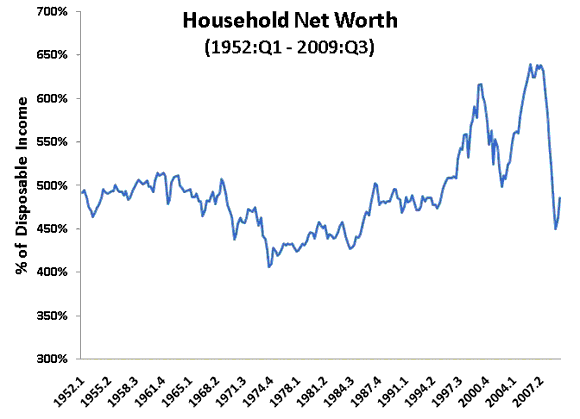The U.S. economic crisis has been called by some observers as a balance sheet recession given the deterioration of the balance sheets in the banking system and the household sector. The U.S. banking system’s balance sheets certainly took a beating during the crisis, but some progress has been made in repairing them. The IMF, for example, shows in its latest Global Financial Stability Report (chapter 1, pp. 7-9) that 60% of needed writedowns of U.S. bank assets had already occurred by late 2009. The November 2009 OECD Economic Outlook notes similar improvements, including sizable capital injections. Of course, there are still more writedowns to do, bank lending is still anemic, and much of the banking system’s balance sheet problems have only been transferred to the Fed’s balance sheet. Still, there has been some meaningful repair to banking system’s balance sheet and that is more than can be said for the household balance sheet. This can be seen by examining the flow of funds data for the households, specially household net worth (i.e. household assets minus household liabilities). The figure below graphs this series as a percent of disposable income:

Note that household net worth as a percent of disposable income reached its lowest point during the crisis in 2009:Q1 with a value of about 450%. At this point, household net worth was put back to where it was in late 1985! For the latest observation of 2009:Q3 household net worth is about 485%, which is approximately where it was on average for the entire 1987:Q1-1993:Q1 period. The bottom line is that household balance sheets have been put back almost two decades. This is both amazing and alarming.
Now repairing household balance sheets will not be an easy task. Here are the options: First, reduce household liabilities by (1) writing down claims against households and/or (2) wide-scale household bankruptcy. Second, increase household assets through (3) a new asset boom cycle and/or (4) increased household saving. Options (1) and (2) are undesirable since they would add further disruptions to an already weakened financial system. Option (3) seems unlikely unless there is some truly new innovation (e.g. green energy) that takes off. That leaves option (4) which is already happening as the U.S. personal saving rate (and overall private) saving rate has increased since the downturn. This approach to improving household balance sheets , however, creates its own set of problems. First, it is not a quick fix. It may take years this way to fully repair household balance sheets that have been put back two decades. Second, as noted by Martin Wolf, the higher household saving means a drop in total spending and ultimately broader economic activity. As a result, government spending has stepped in to fill the aggregate demand gap by running budget deficits. However, given that the decline in spending by households may last years the aggregate demand gap spending by the government may also last years. This , in turn, raises the specter of sovereign bankruptcy. In short, in the absence of another another asset boom the U.S. economy faces the possibility of wide-scale private sector bankruptcy or public sector bankruptcy. Martin Wolf agrees as does Paul Krugman. You can run but you cannot hide from the problems with household balance sheets.
- Bulenox: Get 45% to 91% OFF ... Use Discount Code: UNO
- Risk Our Money Not Yours | Get 50% to 90% OFF ... Use Discount Code: MMBVBKSM
Disclaimer: This page contains affiliate links. If you choose to make a purchase after clicking a link, we may receive a commission at no additional cost to you. Thank you for your support!



Leave a Reply